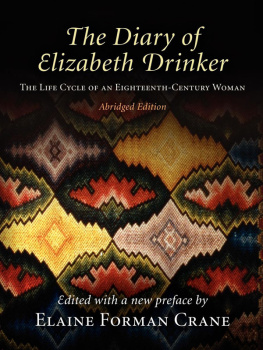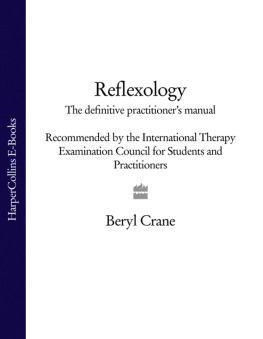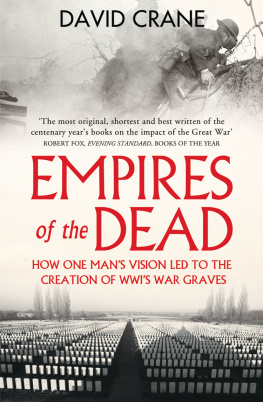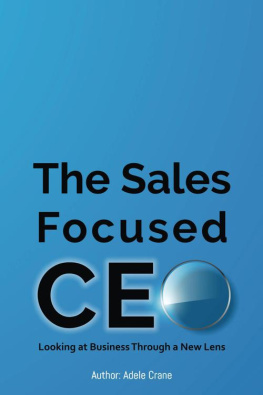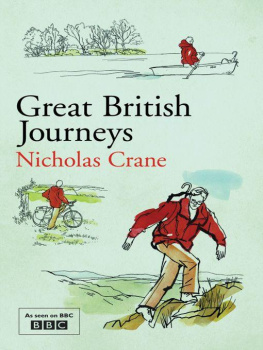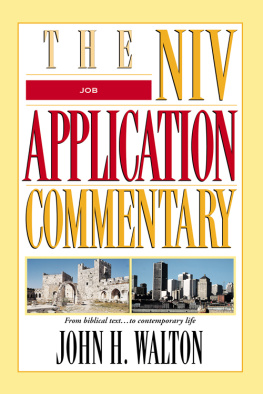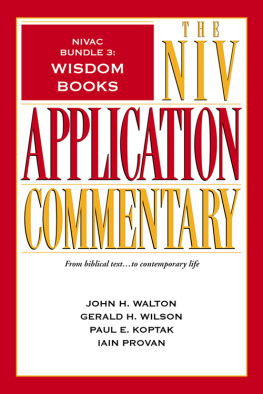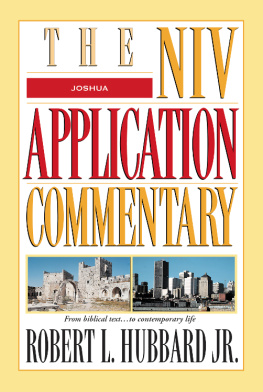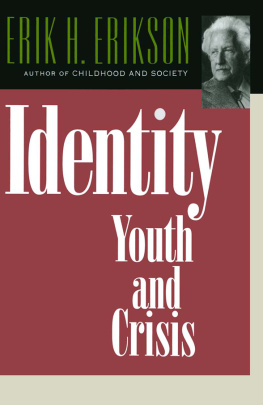All rights reserved. Except for brief quotations used for purposes of review or scholarly citation, none of this book may be reproduced in any form by any means without written permission from the publisher.
Drinker, Elizabeth Sandwith, 1734-1807.
The diary of Elizabeth Drinker : the life cycle of an eighteenth-century woman / edited, with a new preface, by Elaine Forman Crane. Abridged ed.
p. cm.
First published 1994 by Northeastern University PressT.p. verso.
Includes bibliographical references and indexes.
ISBN 978-0-8122-2077-3 (alk. paper)
1. Drinker Elizabeth Sandwith, 1734-1807Diaries. 2. WomenPennsylvaniaPhiladelphiaDiaries. 3. QuakersPennsylvaniaPhiladelphiaDiaries. 4. WomenPennsylvaniaPhiladelphiaSocial life and customs18th century. 5. QuakersPennsylvaniaPhiladelphiaSocial life and customs18th century. 6. ChildbirthPennsylvaniaPhiladelphiaHistory18th century. 7. VaccinationPennsylvaniaPhiladelphiaHistory18th century. 8. MedicinePennsylvaniaPhiladelphiaHistory18th century. 9. Philadelphia (Pa.)Social life and customs18th century. 10. Philadelphia (Pa.)Biography. I. Title.
F1 58.9 F89 D752 2009
974.8'1103092dc22
[B]
2009009381
Preface
A Woman for All Seasons
Elizabeth Drinker and I go back a long way. We met by chance at the Historical Society of Pennsylvania about three decades ago, and since thencourtesy of her diary and the passage of timeshe has been a friend, sister, or mother (depending on her age and mine). I have always maintained that historians are drawn to specific subjects consciously or unconsciously and for reasons that do not easily succumb to analysis. I suspect this is why there are aspects of Elizabeth Drinker's life that resonate in my own world, something that was repeatedly confirmed during the ten years and more it took to transcribe, edit, and annotate what turned out to be two thousand pages of text. The three-volume unabridged diary was published in 1991; the condensed Life Cycle of an Eighteenth-Century Woman in 1994. This preface marks the republication of the abridged version. Its purpose is to review the secrets that the diary has already yielded and to propose new ways of translating Drinker's words into historical lessons.
While most historians who have mined the diary since its twentieth-century incarnation have had something to say about Drinker as a person, the majority have taken greater interest in Drinker's world than in Drinker herself. As a result, many recent scholars have sifted through the diary for information about Philadelphia, yellow fever, the Revolution, or servitude rather than exploring it to construct a biography of an extraordinary woman. Nevertheless, a few historians have tried to unravel Drinker's personal philosophy and, in so doing, have come closer to revealing the person behind the quill.
Susan Branson, for example, approaches Drinker through her political ideology in the context of postrevolutionary developments in Philadelphia. Her analysis of Drinker's language shows the emergence of Drinker's strong Federalist principles, putting to rest the assumption that women were apolitical creatures. Drinker's political outlook also takes center stage in an article by Judith Van Buskirk, who uses the diary to investigate the experiences of women during the Revolutionary War. Van Buskirk concludes that what Elizabeth Drinker and other women saw and heard under the British and American occupations of Philadelphia shaped their political persuasions and that, because of these experiences, Drinker remained a keen observer of politics throughout her life. True enough, although one could argue that women (like Drinker) were politically savvy long before the revolutionary movement forced them to take sides. Indeed, as Branson and Van Buskirk note, the proliferation of newspapers and pamphlets that flooded Philadelphia in the pre- and postrevolutionary years were ideology-forming weapons.
Drinker's voracious appetite for the written word also holds Mary Kelley's attention in her highly acclaimed book, Learning to Stand and Speak. Kelley points to Drinker's eclectic taste in reading, the multiplicity of themes and range of opinions that attracted her, as evidence of Drinker's tolerant worldview. If her tolerance had limits (which it did!), Drinker was still, as Kelley puts it, a cosmopolitan reader. By linking Drinker to her literary preferences, Kelley also draws attention to Drinker as a biographical subject rather than as a mere backdrop to external and peripheral issues.
Straddling the two themes (Drinker as subject and Drinker's diary as research tool) is Helena Wall's essay on illness in Elizabeth Drinker's household and her role as caregiver. Wall converts Drinker's concerns about the fragility of life into a thesis about childhood without sacrificing Drinker's personal reaction to sickness and death. On the one hand, Wall addresses Drinker's grief over the loss of her young son, Henry, in 1769; on the other, she interprets the experience of childhood through the diary of a mother and grandmother.
More directly concerned with health as it related to the development of medical practices in Philadelphia, Sarah Blank Dine deftly culls Drinker's journal for information about changing views on childbirth and inoculation as the eighteenth century wanes. Although Drinker is somewhat reticent about her own experiences, she freely discusses the many pregnancies and lying-ins of her three daughters. As for inoculation and vaccination, Drinker confirms the distrust and ambivalence about these procedures that lingered as Philadelphians debated the best method of keeping smallpox at bay.
Historians have also found that Drinker's diary lends insight into race and racial relationships in the new Republic, topics analyzed by both Susan Klepp and Alison Duncan Hirsch. In a 1994 William and Mary Quarterly article on racial differences in mortality in eighteenth-century Philadelphia, Klepp notes that, among her other findings, she learned from Drinker just how elusive social equality was for blacks even as emancipation freed African Americans from slavery. Hirsch's interest in multiraciality led her to consider Drinker's use of words to describe racial distinctions. As a result, Hirsch was able to draw conclusions about the words mulatto and yellow as they were understood in eighteenth-century Philadelphia.
One of the amazing aspects of Drinker's fifty-year journalapart from its formidable lengthis the way historians have drawn on it each time their attention turns in a new direction. Elizabeth Drinker may not have been a feminist as the term is commonly defined, but as a source for the study of women's lives and the interpretation of gender roles in early America, the diary has few competitors. Debra O'Neil investigated the plight of single, female domestic workers through Drinker's pages and concluded that the shift from indentured servitude to wage labor created hardships, particularly for single women. More recently, Karin Wulf has expanded on O'Neil's assertions about the economic frailty of never married and widowed women as they clustered in urban areas in the eighteenth century. Although Wulf is more interested in the less affluent women with whom Drinker came in contact, the diary also proves an unusual resource for understanding the place of more prosperous single women in expanded households. Mary Sandwith, Elizabeth's unmarried older sister, took up residence with Elizabeth and Henry Drinker, sharing their home and domestic responsibilities during her entire adult life.

